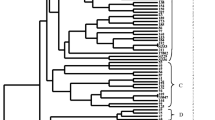Abstract
Between October 2008 and June 2009, 15 samples of 10 live oysters each (Crassostrea rhizophorae) measuring 8.31–10.71 cm were purchased from a restaurant on the seashore of Fortaleza, Brazil. The Vibrio count ranged from 75 (estimated) to 43,500 CFU/g. Fourteen species were identified among the 56 isolated Vibrio strains, with V. parahaemolyticus as the most prevalent. Two of the 17 V. parahaemolyticus strains were urease-positive and tdh- and trh-positive on multiplex PCR, but neither produced β-hemolysis halos in Wagatsuma agar. Thus, fresh oysters served in natura in Fortaleza, Brazil, were found to contain Vibrio strains known to cause gastroenteritis in humans.

Similar content being viewed by others
References
Bagchi K, Echeverria P, Arthur JD, Sethabutr O, Serichantalergs O, Hoge CW (1993) Epidemic of diarrhea caused by Vibrio cholerae non-O1 that produced heat-stable toxin among Khmers in a camp in Thailand. J Clin Microbiol 31:1315–1317
Bej AK, Patterson DP, Brasher CW, Vickery MCL, Jones DD, Kaysner CA (1999) Detection of total and hemolysin-producing Vibrio parahaemolyticus in shellfish using multiplex PCR amplification of tl, tdh and trh. J Microbiol Methods 36:215–225
Chan K-Y, Woo ML, Lam LY, French GL (1989) Vibrio parahaemolyticus and other halophilic vibrios associated with seafood in Hong Kong. J Appl Microbiol 66:57–64
Dileep V, Kumar HS, Kumar Y, Nishibuchi M, Karunasagar I, Karunasagar I (2003) Application of polymerase chain reaction for detection of Vibrio parahaemolyticus associated with tropical seafoods and coastal environment. Lett Appl Microbiol 36:423–427
Downes MP, Ito K (2001) Compendium of methods for the microbiological examination of foods, 4th edition. APHA, Washington, DC
Hofer E (1983) Primeiro isolamento e identificação de Vibrio parahaemolyticus no Brasil de infecção grastrointestinal humana. Rev Microbiol 14:174–175
Honda T, Abad-Lapuebla MA, Ni Y, Yamamoto K, Miwatani T (1991) Characterization of a new thermostable direct haemolysin produced by a Kanagawa-phenomenon-negative clinical isolate of a Vibrio parahaemolyticus. J Gen Microbiol 137:253–259
Iida T, Suthienkul O, Park K-S, Tang G-Q, Yamamoto RK, Ishibashi M, Yamamoto K, Honda T (1997) Evidence for genetic linkage between the ure and trh genes in Vibrio parahaemolyticus. J Med Microbiol 46:639–645
International Commission on Microbiological Specifications for Foods ICMSF (1978) Microorganisms in foods. Part III: specifications for ingredients, media, and reagents, 2nd edition. University of Toronto Press, Toronto, p 338
Kelly MT, Stroh EMD (1989) Urease positive, Kanagawa negative Vibrio parahaemolyticus from patients and the environment in the Pacific Northwest. J Clin Microbiol 27:2820–2822
Matté GR, Matté MH, Rivera IG, Martins TM (1994) Distribution of potentially pathogenic vibrios in oysters from a tropical region. J Food Prot 57:870–873
Morris JG Jr (2003) Cholera and other types of vibriosis: a story of human pandemics and oyster on the half shell. Clin Infect Dis 37:272–280
Nishibuchi M, Kaper JB (1995) Thermostable direct hemolysin gene of Vibrio parahaemolyticus: a virulence gene acquired by a marine bacterium. Infect Immun 63:2093–2099
Nishibuchi M, Ishibashi M, Takeda Y, Kaper JB (1985) Detection of the thermostable direct hemolysin gene and related DNA sequences in Vibrio parahaemolyticus and other Vibrio species by the DNA colony hybridization test. Infect Immun 49:481–486
Noguerola I, Blanch AR (2008) Identification of Vibrio spp with a set of dichotomous keys. J Appl Microbiol 105:175–185
Okuda J, Nishibuchi M (1998) Manifestation of the Kanagawa phenomenon, the virulence-associated phenotype, of Vibrio parahaemolyticus depends on a particular single base change in the promoter of the thermostable direct haemolysin gene. Mol Microbiol 30:499–511
Oliver JD, Kaper JB (1997) Vibrio species. In: Doyle MP, Beuchat LR, Montville TJ (eds) Food microbiology: fundaments and frontiers. ASM Press, Washington, DC, pp 228–264
Pereira CS, Viana CM, Rodrigues DP (2007) Vibrios patogênicos em ostras (Crassostrea rhizophorae) servidas em restaurantes no Rio de Janeiro: um alerta para a Saúde Pública. Rev Soc Bras Med Trop 40:300–303
Robert-Pillot A, Guénolé A, Lesne J, Delesmont R, Fournier J-M, Quilici M-L (2004) Occurrence of the tdh and trh genes in Vibrio parahaemolyticus isolates from waters and raw shellfish collected in two French coastal areas and from seafood imported into France. Int J Food Microbiol 91:319–325
Sousa OV, Vieira RHSF, Menezes FGR, Reis CMF, Hofer E (2004) Detection of Vibrio parahaemolyticus and Vibrio cholerae in oyster, Crassostrea rhizophorae, collected from a natural nursery in the Cocó river estuary, Fortaleza, Ceará, Brazil. Rev Inst Med Trop São Paulo 46:59–62
Su Y-C, Liu C (2007) Vibrio parahaemolyticus: a concern of seafood safety. Food Microbiol 24:549–558
Suthienkul O, Ishibashi M, Iida T, Nettip N, Supavej S, Eampokalap B, Makino M, Honda T (1995) Urease production correlates with possession of the trh gene in Vibrio parahaemolyticus strains isolated in Thailand. J Infect Dis 172:1405–1408
Vieira RHS, Vasconcelos RF, Carvalho EMR (2007) Quantificação de víbrios, de coliformes totais e termotolerantes em ostra nativa Crassostrea rhizophorae, e na água do estuário do Rio Jaguaribe, Fortim CE. Revista Brasileira de Higiene e Sanidade Animal 1:1–13
Vieira RHSF, Sousa OV, Costa RA, Theophilo GND, Macrae A, Rodrigues DP (2010) Raw oyster can be a risk for infections. Braz J Infect Dis 14:83–87
Wagatsuma S (1968) A medium for the test of the hemolytic activity of Vibrio parahaemolyticus. Media Circ 13:159–162
Acknowledgments
The study was carried out with financial support from CNPq.
Author information
Authors and Affiliations
Corresponding author
Rights and permissions
About this article
Cite this article
Vieira, R.H.S.F., Costa, R.A., Menezes, F.G.R. et al. Kanagawa-Negative, tdh- and trh-Positive Vibrio parahaemolyticus Isolated from Fresh Oysters Marketed in Fortaleza, Brazil. Curr Microbiol 63, 126–130 (2011). https://doi.org/10.1007/s00284-011-9945-x
Received:
Accepted:
Published:
Issue Date:
DOI: https://doi.org/10.1007/s00284-011-9945-x




